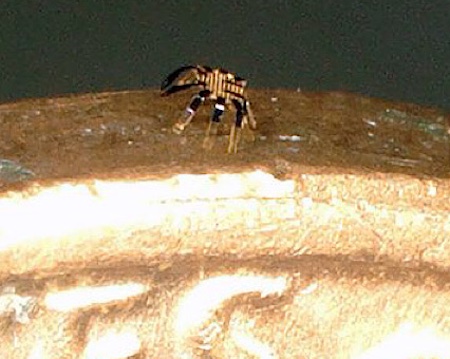Science Fiction
Dictionary
A B C D E F G H I J K L M N O P Q R S T U V W X Y Z
Smallest Remote-Controlled Walking Robot Crabs

Northwestern University engineers have invented the world’s smallest remote-controlled walking robot, just a half millimeter wide. Could any science fiction writer, however imaginative, conceive of a walking robot no bigger than a grain of sand?

(Remote-controlled walking robot crab)
It took a year and a half to create the miniscule metal creatures, said coauthor John A. Rogers, the Louis Simpson and Kimberly Querrey Professor of Materials Science and Engineering at Northwestern University.His team was comprised of students across varying academic levels who combined critical- and creative-thinking skills to design robots that looked like crabs as well as other animals like inchworms and crickets, he said.
Some students found the sideways motion of crabs to be amusing, which was the inspiration behind the crab robot, Rogers said. The tiny robot can also twist, turn and jump, he added.
The robots, which are made of a malleable shape-memory alloy, start out as flat objects, similar to a piece of paper. The legs and arms are bent so the robot can stand, he said. The crab stays standing on its legs until heat is used to get the crab to move, Rogers said.
A metallic object made of shape-memory alloy can be deformed but returns to its original shape once heat is applied to it, he explained.
(Via ImpactLab)
Technovelgy readers recall the scarab robot imagined by Raymond Z. Gallun in 1936. But I'd like to point out the ultra-microrobot from Gallun's 1937 story A Menace in Miniature.

("A robot no bigger than a grain of sand?)
You might want to compare the walking crab robot with the smallest robot in 2007, arguably Pico, that could turn on a dime.
(Pico really can turn on a dime)
Scroll down for more stories in the same category. (Story submitted 6/11/2022)
Follow this kind of news @Technovelgy.| Email | RSS | Blog It | Stumble | del.icio.us | Digg | Reddit |
Would
you like to contribute a story tip?
It's easy:
Get the URL of the story, and the related sf author, and add
it here.
Comment/Join discussion ( 0 )
Related News Stories - (" Robotics ")
Golf Ball Test Robot Wears Them Out
"The robot solemnly hit a ball against the wall, picked it up and teed it, hit it again, over and again...' - Frederik Poh, 1954.
PaXini Supersensitive Robot Fingers
'My fingers are not that sensitive...' - Ray Cummings, 1931.
Artificial Skin For Robots Is Coming Right Along
'... an elastic, tinted material that had all the feel and appearance of human flesh and epidermis.' - Harl Vincent (1934)
Robot Guard Dog On Duty
I might also be thinking of K-9 from Doctor Who.
Technovelgy (that's tech-novel-gee!) is devoted to the creative science inventions and ideas of sf authors. Look for the Invention Category that interests you, the Glossary, the Invention Timeline, or see what's New.
Science Fiction
Timeline
1600-1899
1900-1939
1940's 1950's
1960's 1970's
1980's 1990's
2000's 2010's
Current News
Golf Ball Test Robot Wears Them Out
"The robot solemnly hit a ball against the wall, picked it up and teed it, hit it again, over and again...'
Boring Company Vegas Loop Like Asimov Said
'There was a wall ahead... It was riddled with holes that were the mouths of tunnels.'
Rigid Metallic Clothing From Science Fiction To You
'...support the interior human structure against Jupiter’s pull.'
Is The Seattle Ultrasonics C-200 A Heinlein Vibroblade?
'It ain't a vibroblade. It's steel. Messy.'
Roborock Saros Z70 Is A Robot Vacuum With An Arm
'Anything larger than a BB shot it picked up and placed in a tray...'
A Beautiful Visualization Of Compact Food
'The German chemists have discovered how to supply the needed elements in compact, undiluted form...'
Bone-Building Drug Evenity Approved
'Compounds devised by the biochemists for the rapid building of bone...'
Secret Kill Switch Found In Yutong Buses
'The car faltered as the external command came to brake...'
Inmotion Electric Unicycle In Combat
'It is about the size and shape of a kitchen stool, gyro-stabilized...'
Grok Scores Best In Psychological Tests
'Try to find out how he ticks...'
PaXini Supersensitive Robot Fingers
'My fingers are not that sensitive...'
Congress Considers Automatic Emergency Braking, One Hundred Years Too Late
'The greatest problem of all was the elimination of the human element of braking together with its inevitable time lag.'
The Desert Ship Sailed In Imagination
'Across the ancient sea floor a dozen tall, blue-sailed Martian sand ships floated, like blue smoke.'
The Zapata Air Scooter Would Be Great In A Science Fiction Story
'Betty's slapdash style.'
Thermostabilized Wet Meat Product (NASA Prototype)
There are no orbiting Michelin stars. Yet.
Could Crystal Batteries Generate Power For Centuries?
'Power could be compressed thus into an inch-square cube of what looked like blue-white ice'
